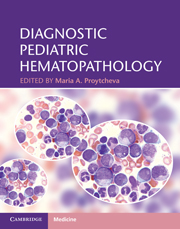Book contents
- Frontmatter
- Contents
- List of contributors
- Acknowledgements
- Introduction
- Section 1 General and non-neoplastic hematopathology
- Section 2 Neoplastic hematopathology
- 10 Chromosome abnormalities of hematologic malignancies
- 11 Expression profiling in pediatric acute leukemias
- 12 Myeloproliferative neoplasms
- 13 Myelodysplastic/myeloproliferative neoplasms
- 14 Myelodysplastic syndromes and therapy-related myeloid neoplasms
- 15 Acute myeloid leukemia and related precursor neoplasms
- 16 Hematologic abnormalities in individuals with Down syndrome
- 17 Precursor lymphoid neoplasms
- 18 Advances in prognostication and treatment of pediatric acute leukemia
- 19 The effect of chemotherapy, detection of minimal residual disease, and hematopoietic stem cell transplantation
- 20 Pediatric small blue cell tumors metastatic to the bone marrow
- 21 Pediatric mature B-cell non-Hodgkin lymphomas
- 22 Pediatric mature T-cell and NK-cell non-Hodgkin lymphomas
- 23 Hodgkin lymphoma
- 24 Immunodeficiency-associated lymphoproliferative disorders
- 25 Histiocytic proliferations in childhood
- 26 Cutaneous and subcutaneous lymphomas in children
- Index
- References
20 - Pediatric small blue cell tumors metastatic to the bone marrow
from Section 2 - Neoplastic hematopathology
Published online by Cambridge University Press: 03 May 2011
- Frontmatter
- Contents
- List of contributors
- Acknowledgements
- Introduction
- Section 1 General and non-neoplastic hematopathology
- Section 2 Neoplastic hematopathology
- 10 Chromosome abnormalities of hematologic malignancies
- 11 Expression profiling in pediatric acute leukemias
- 12 Myeloproliferative neoplasms
- 13 Myelodysplastic/myeloproliferative neoplasms
- 14 Myelodysplastic syndromes and therapy-related myeloid neoplasms
- 15 Acute myeloid leukemia and related precursor neoplasms
- 16 Hematologic abnormalities in individuals with Down syndrome
- 17 Precursor lymphoid neoplasms
- 18 Advances in prognostication and treatment of pediatric acute leukemia
- 19 The effect of chemotherapy, detection of minimal residual disease, and hematopoietic stem cell transplantation
- 20 Pediatric small blue cell tumors metastatic to the bone marrow
- 21 Pediatric mature B-cell non-Hodgkin lymphomas
- 22 Pediatric mature T-cell and NK-cell non-Hodgkin lymphomas
- 23 Hodgkin lymphoma
- 24 Immunodeficiency-associated lymphoproliferative disorders
- 25 Histiocytic proliferations in childhood
- 26 Cutaneous and subcutaneous lymphomas in children
- Index
- References
Summary
Introduction
Bone marrow (BM) studies are often performed in children with solid tumors for initial diagnosis, for staging of disease, for monitoring of response to therapy, and for detecting recurrent diseases. In general, the presence of BM metastasis indicates high-stage disease and is associated with inferior outcome. Different pediatric solid tumors, however, metastasize with variable frequency depending on the tumor type. While neuroblastoma and alveolar rhabdomyosarcoma frequently present with BM metastases, other tumors such as pediatric brain tumors, non-rhabdomyosarcoma soft tissue sarcomas, and retinoblastoma metastasize less often. Some tumors, such as Wilms tumor, almost never metastasize to the BM and seldom require bone marrow evaluation. There is no single clinical finding that can predict the presence of BM metastasis in a child with a solid tumor. Bone pain, spinal cord compression, or pathologic fractures, although frequently reported, are non-specific and unreliable in confirming BM metastasis.
The standard for staging BM evaluation for solid tumors requires bilateral aspirates and biopsies with at least 1 cm of BM, not including the bone cortex or cartilage. BM biopsy may not be feasible in young infants, and a combination of MRI scans, BM aspirates, and ancillary studies may be acceptable for proper diagnosis. This approach, while sufficient for the diagnosis of metastasis, is limited in monitoring response to therapy and further follow-up. Thus, staging BM biopsy should be attempted when possible to overcome this limitation.
- Type
- Chapter
- Information
- Diagnostic Pediatric Hematopathology , pp. 379 - 394Publisher: Cambridge University PressPrint publication year: 2011
References
- 1
- Cited by



